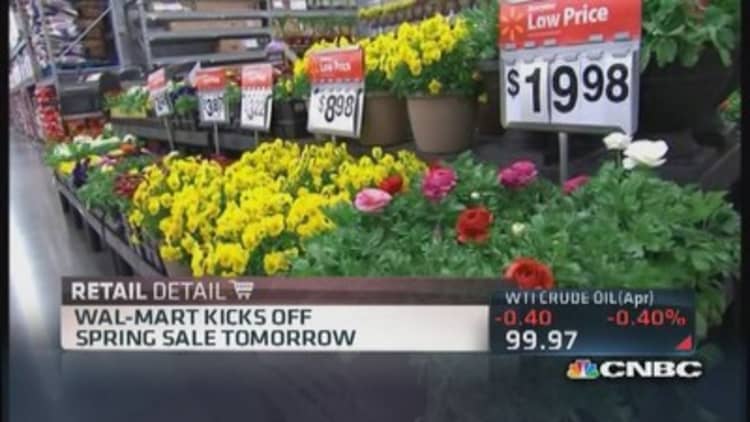
Talk about deja vu.
It's been only four months since shoppers dodged elbows and raced through the aisles to capture Black Friday's best deals. But the sales are making a comeback at Wal-Mart for spring, as the big box retailer looks to take a bite out of the growing home improvement sector.
On Friday, Wal-Mart is slashing prices and debuting deeper offerings in its outdoor living and lawn and garden segments. The move puts pressure on home improvement leaders Home Depot and Lowe's, which consider the critical spring selling season their version of Christmas.
"Nobody does Black Friday better than Wal-Mart, and we're bringing that same philosophy to our new outdoor living, lawn and garden event," said Michelle Gloeckler, senior vice president of the retailer's U.S. home division.
(Read more: Home Depot, Lowe's say put down that snow thrower!)
For the spring kickoff, which ends March 29, Wal-Mart will offer 30 to 50 percent discounts on lawnmowers, patio furniture, charcoal grills and flowers. It will also match competitors' prices at the register. In addition to savings, the retailer expanded its offerings in a number of categories, including potting soil, and added a line of sheds.
Gloeckler said the decision to ramp up these segments came in response to customer demand.
"Consumers are expanding their living space outside their home, and people are spending money on their homes," she said. Both trends could give a boost to sales within the category.
The move also follows the discount retailer's fourth-straight quarter of U.S. same-store sales losses, announced last month. Those losses have caused some analysts to question where Wal-Mart's growth will come from.
(Read more: GameStop down as Wal-Mart unveils trade-in program)
According to industry research firm IBISWorld, the home improvement industry is expected to reach $143.6 billion in revenue in 2014. That figure is based on stores that primarily sell home repair and improvement products, so it excludes Wal-Mart, which is defined as a department store in their reporting structure. Wal-Mart does not break down its sales for the home improvement section.
Home Depot and Lowe's, which ring up about 30 percent of their sales from May to August, aren't going down without a fight. The retailers—which IBISWorld says make up about 90 percent of home improvement sales—also host spring sales events that try to conjure up the Black Friday magic, and this year is no different. These retailers are hoping that bargain-hungry shoppers will see the words "Black Friday" as shorthand for really great value.
For Lowe's, these events kicked off last weekend in the Southern states, such as Florida and Texas, where spring arrives earlier. At Home Depot, they kick off April 3.
(Read more: New Amazon Prime fee makes shoppers do the math)
In their recent earnings calls, both retailers sounded a bullish note on 2014, as analysts have pointed to an improving housing market, the need for home improvements following a brutal winter, and pent-up demand as potential catalysts.
And despite a relentless dumping of snow across the Midwest and much of the Northeast, Planalytics, a consulting firm that analyzes the effect of weather on consumer demand, predicts sales in the lawn and garden category will rise 5 percent for March, carried by warmer temperatures in the Southeast.
"We're tired of winter," Evan Gold, senior vice president of client services at Planalytics, told CNBC ahead of Wal-Mart's announcement.
The discounter's push into the home improvement market is its second announcement this week that encroaches on another retailer's territory. On Tuesday, Wal-Mart said it will offer a program where shoppers can trade in used video games for a Wal-Mart or Sam's Club eGift card. Since the announcement, GameStop's shares have fallen more than 5 percent.
—By CNBC's Krystina Gustafson. Follow her on Twitter @KrystinaGustafs.


